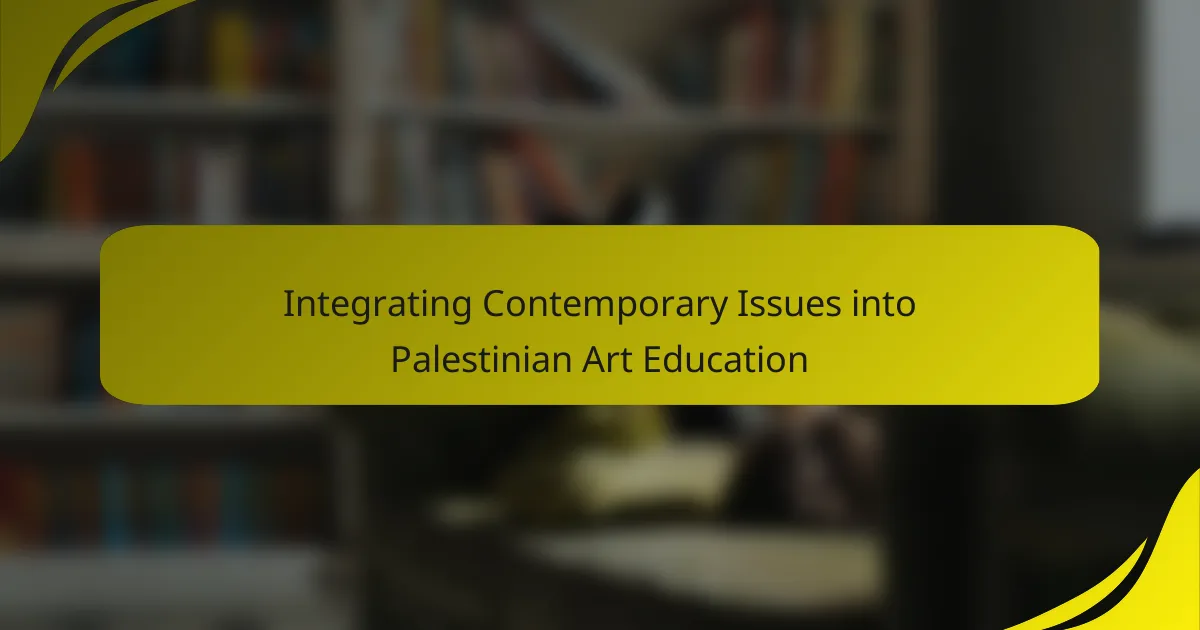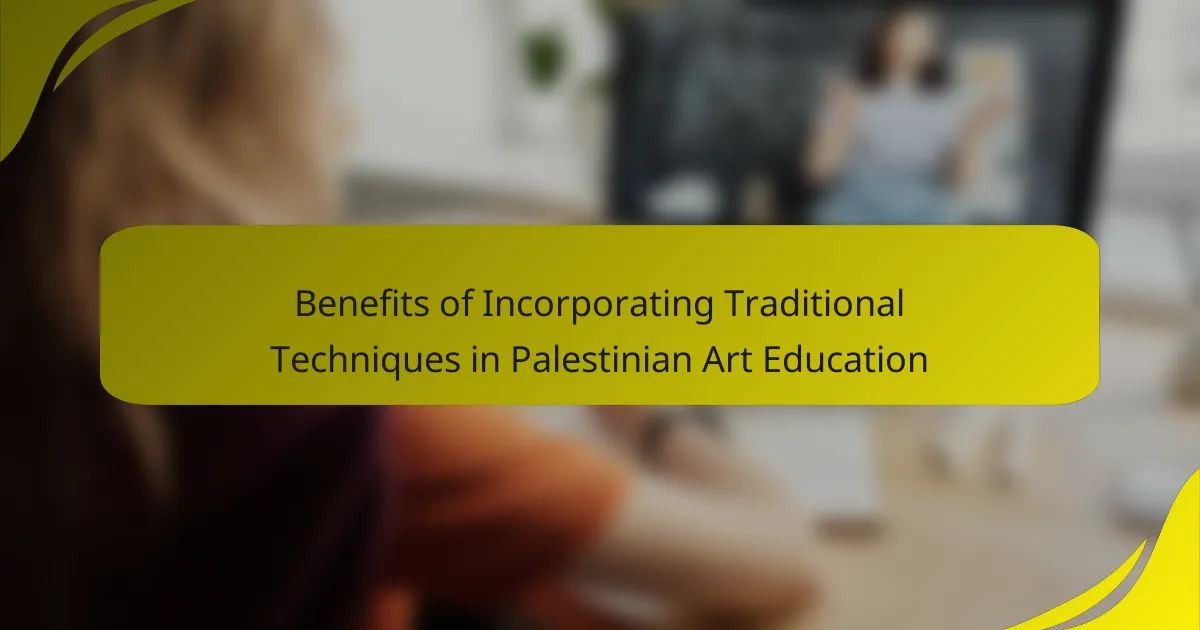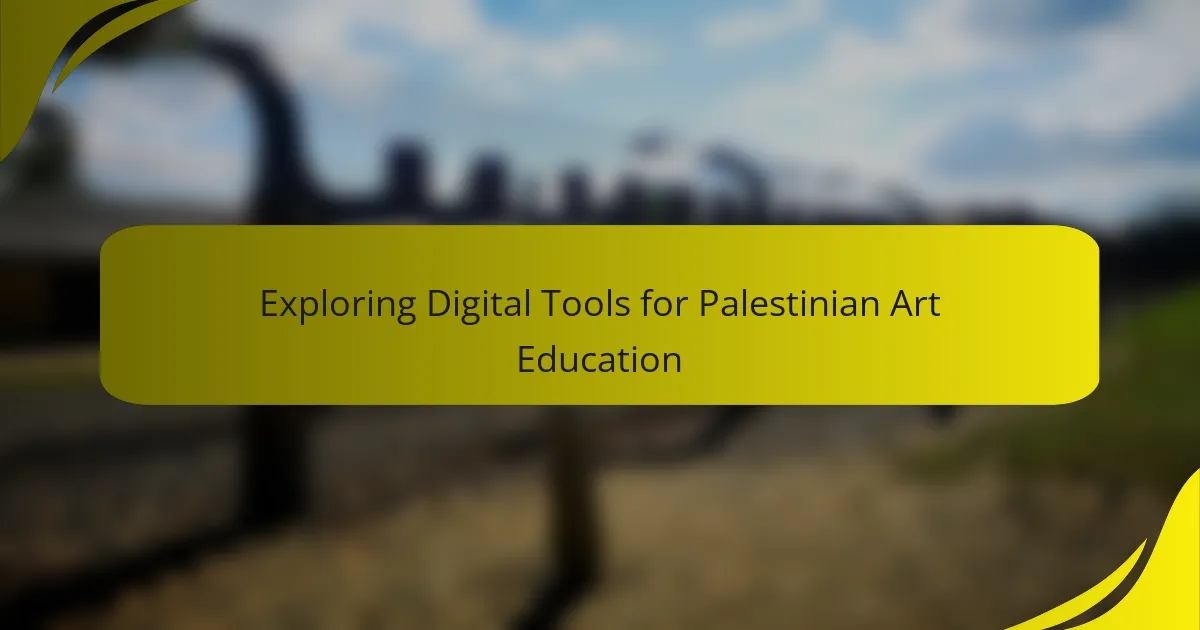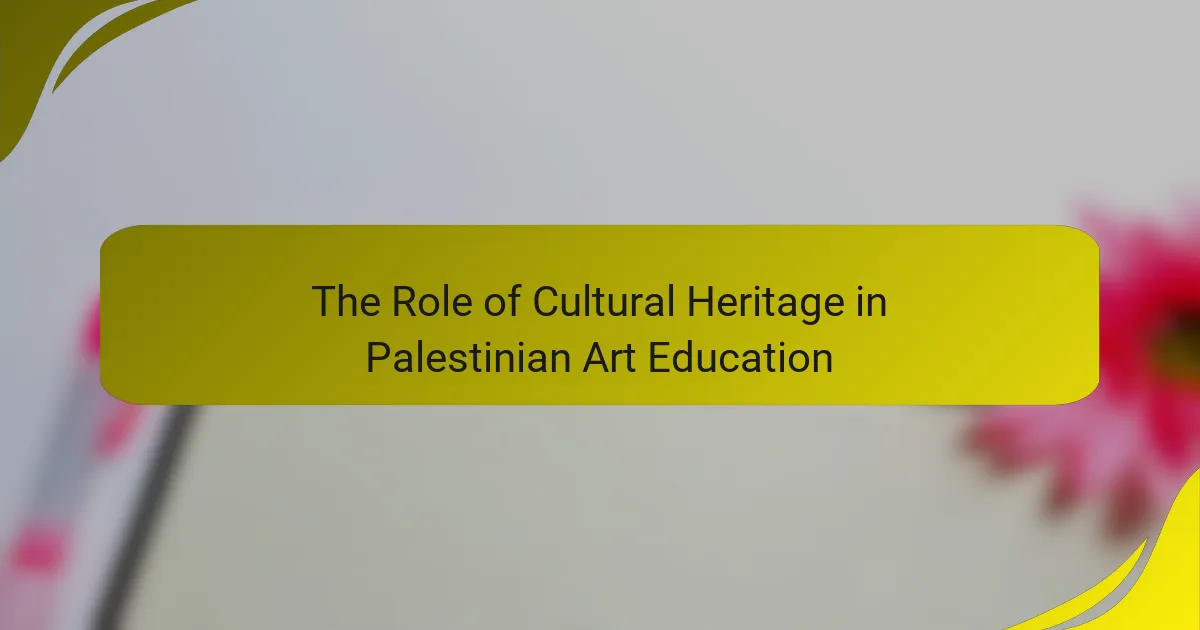Palestinian art education is currently facing significant challenges, primarily due to limited resources and political instability. Educational institutions struggle with funding and access to essential materials, impacting the development of art programs. Despite these obstacles, there is a notable increase in interest among Palestinian youth, leading to the emergence of community initiatives aimed at fostering creativity. Organizations such as the Palestinian Art Academy are actively working to provide training and opportunities, resulting in rising enrollment in art programs. However, the overall infrastructure for art education remains underdeveloped compared to global standards.
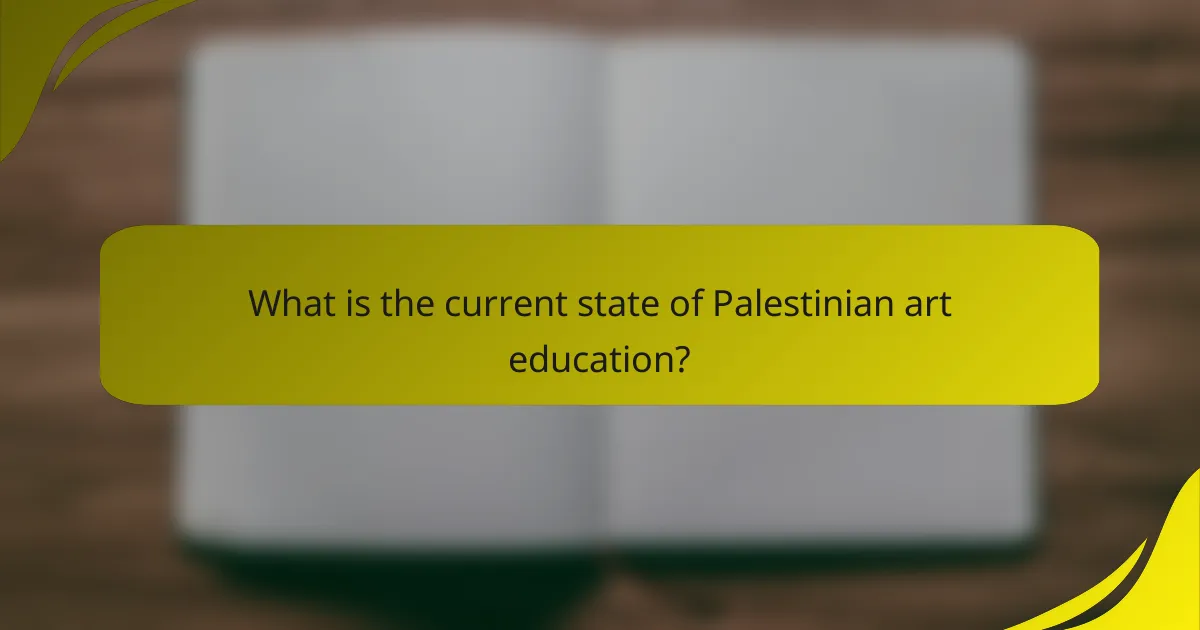
What is the current state of Palestinian art education?
The current state of Palestinian art education is characterized by limited resources and significant challenges. Educational institutions face constraints due to political instability. Many art programs struggle with funding and access to materials. Despite these obstacles, there is a growing interest in art among Palestinian youth. Community initiatives are emerging to foster creativity and expression. Organizations like the Palestinian Art Academy are working to provide training and opportunities. Recent surveys indicate an increase in enrollment in art programs. However, the overall infrastructure remains underdeveloped compared to global standards.
How has Palestinian art education evolved over the years?
Palestinian art education has evolved significantly over the years. Initially, art education was limited due to political and economic constraints. In the late 20th century, institutions began to emerge, focusing on Palestinian identity and cultural expression. The establishment of universities in the 1990s provided formal art programs. These programs integrated traditional and contemporary art forms. Recently, there has been a rise in community-based art initiatives. These initiatives aim to engage youth and promote cultural dialogue. The impact of social media has also expanded the reach of Palestinian artists. Overall, the evolution reflects resilience and adaptability in the face of challenges.
What historical factors have influenced Palestinian art education?
Palestinian art education has been influenced by various historical factors including political conflict, cultural heritage, and colonialism. The ongoing Israeli-Palestinian conflict has shaped educational policies and access to resources. Restrictions on movement and freedom have limited opportunities for Palestinian artists and educators. Cultural heritage plays a vital role in shaping artistic expression and education, reflecting the identity and history of the Palestinian people. Additionally, colonial influences from the Ottoman Empire and British Mandate have left lasting impacts on the structure of educational systems. The establishment of institutions like the Palestine Museum of Natural History has also contributed to the development of art education in the region. These historical contexts have significantly shaped the curriculum, teaching methods, and accessibility of art education in Palestine.
What are the key institutions involved in Palestinian art education?
Key institutions involved in Palestinian art education include the University of the Arts in Palestine, the International Academy of Art Palestine, and the Al-Quds Bard College. The University of the Arts in Palestine offers various programs focused on visual arts and design. The International Academy of Art Palestine provides professional training and workshops for emerging artists. Al-Quds Bard College combines liberal arts education with a focus on creative practices. These institutions contribute significantly to nurturing artistic talent in Palestine. They play a crucial role in developing the local art scene and fostering cultural expression.
What are the main trends shaping the future of Palestinian art education?
The main trends shaping the future of Palestinian art education include increased digital integration, community engagement, and a focus on cultural identity. Digital integration allows for innovative teaching methods and broader access to resources. Community engagement fosters collaboration between artists and educators, enhancing practical learning experiences. A focus on cultural identity supports the preservation and expression of Palestinian heritage through art. These trends are influenced by ongoing socio-political challenges and the desire for artistic expression in the region.
How is technology impacting art education in Palestine?
Technology is significantly impacting art education in Palestine by enhancing access to resources and fostering creativity. Digital platforms provide students with online art tutorials and virtual galleries. This access bridges gaps caused by limited physical resources. Technology also facilitates collaboration among artists and educators across regions. For instance, online workshops connect Palestinian artists with international mentors. Additionally, social media platforms allow students to showcase their work globally. The integration of technology in art education encourages innovative teaching methods. These advancements prepare students for a competitive art market. Overall, technology is transforming how art is taught and experienced in Palestine.
What role do cultural movements play in shaping art education trends?
Cultural movements significantly influence art education trends by reflecting societal values and priorities. These movements often advocate for inclusivity and diversity in artistic expression. For instance, the feminist movement has led to increased representation of women artists in curricula. Similarly, the civil rights movement has prompted a focus on African American art and history in education. Cultural movements can also inspire new teaching methods and interdisciplinary approaches. They encourage educators to integrate contemporary issues into art lessons, fostering critical thinking. Historical examples include the Harlem Renaissance, which shaped art education by highlighting African American culture. Overall, cultural movements serve as catalysts for evolving art education practices, ensuring they remain relevant to current societal contexts.
What challenges does Palestinian art education face?
Palestinian art education faces significant challenges due to political instability. The ongoing conflict limits resources and access to quality education. Many art institutions struggle with funding and infrastructure. Restrictions on movement hinder collaboration and exposure to global art practices. Additionally, cultural censorship impacts the freedom of expression in art. The curriculum often lacks contemporary relevance and diversity. There is also a shortage of trained art educators. These factors collectively impede the development of a robust art education system in Palestine.
How do political and social factors affect art education in Palestine?
Political and social factors significantly impact art education in Palestine. The ongoing conflict restricts access to resources and funding for educational institutions. Schools often face physical damage and instability, hindering a consistent art curriculum. Social norms can influence the acceptance and promotion of art forms. Additionally, cultural identity plays a crucial role, as art education becomes a means of resistance and expression. The lack of governmental support further complicates the situation. Various organizations strive to provide alternative art education programs, yet they often operate under limited conditions. These challenges shape the landscape of art education in Palestine, affecting both students and educators.
What are the funding and resource limitations for art educators?
Art educators face significant funding and resource limitations. Budget constraints often lead to inadequate supplies and materials for teaching. Many art programs rely on limited public funding, which can fluctuate yearly. This inconsistency affects curriculum development and access to essential tools. Additionally, schools may prioritize core subjects over arts education, resulting in less financial support. Research indicates that art programs in underfunded areas often lack qualified instructors. According to a report by the National Art Education Association, 70% of art educators cite insufficient funding as a primary challenge. These limitations hinder the overall quality of art education and student engagement.
What opportunities exist for enhancing Palestinian art education?
Opportunities for enhancing Palestinian art education include increased access to resources, collaboration with international institutions, and community engagement initiatives. Access to digital tools and online platforms can facilitate remote learning and broaden exposure to diverse artistic practices. Partnerships with global art organizations can provide workshops, mentorship, and funding opportunities. Engaging local communities through art programs can foster cultural expression and support emerging artists. These strategies can enhance the quality and reach of art education in Palestine, promoting creativity and artistic development.
How can community engagement improve art education programs?
Community engagement can significantly enhance art education programs by fostering collaboration and support. Engaged communities provide resources such as funding, materials, and expertise. This collaboration can lead to more diverse and relevant art curricula. Local artists can contribute their skills, enriching the learning experience for students. Community events can showcase student work, boosting confidence and public interest. Research indicates that programs with strong community ties see higher student participation and retention rates. A study by the National Endowment for the Arts found that community involvement increases access to the arts, benefiting educational outcomes. Thus, community engagement is essential for the growth and success of art education programs.
What partnerships can be formed to support art education initiatives?
Partnerships that can be formed to support art education initiatives include collaborations with local schools, art institutions, and non-profit organizations. Local schools can integrate art programs into their curricula, enhancing student engagement. Art institutions can provide resources, workshops, and mentorship opportunities for students. Non-profit organizations often focus on community development and can help fund art projects. Additionally, partnerships with local businesses can create sponsorship opportunities for art events. Collaborating with government agencies can secure grants for art education initiatives. These partnerships can lead to a more robust art education framework that benefits students and communities.
How can we measure the impact of art education in Palestine?
The impact of art education in Palestine can be measured through various quantitative and qualitative methods. Surveys can assess students’ engagement and skill development in art programs. Observations of student artwork can provide insight into creative expression and cultural identity. Interviews with educators can reveal shifts in teaching methods and curriculum effectiveness. Academic performance metrics can show correlations between art education and overall student achievement. Community feedback can gauge the social impact of art initiatives. Documenting participation rates in art programs can highlight accessibility and interest levels. Evaluating exhibition outcomes can illustrate the visibility and appreciation of Palestinian art. These methods collectively provide a comprehensive understanding of art education’s impact in Palestine.
What metrics can be used to evaluate the success of art education programs?
Art education programs can be evaluated using several key metrics. These metrics include student engagement levels, which can be measured through attendance and participation rates. Another important metric is the quality of student artwork, assessed through exhibitions and portfolios. Academic performance in related subjects may also serve as an indicator of success. Feedback from students and parents can provide qualitative insights into program effectiveness. Additionally, the number of community partnerships and collaborations can reflect the program’s impact on the wider community. Research indicates that programs with higher engagement and quality outcomes often correlate with increased student satisfaction and retention rates.
How do students perceive the value of their art education?
Students perceive the value of their art education as multifaceted and essential for personal and professional development. Many students believe that art education fosters creativity and critical thinking skills. It also enhances their ability to express emotions and ideas visually. Research indicates that students who engage in art education report higher levels of self-esteem and confidence. Furthermore, art education can serve as a pathway to various career opportunities in creative industries. A study by the National Endowment for the Arts found that students with arts education perform better academically in other subjects. This suggests that the skills gained in art education are transferable and beneficial across disciplines. Overall, students view their art education as a vital component of their overall educational experience.
What best practices can be adopted for advancing Palestinian art education?
Integrating community engagement is a best practice for advancing Palestinian art education. This approach fosters collaboration between artists, educators, and local communities. Workshops and public art projects can enhance participation and relevance. Incorporating technology into art education is also essential. Digital tools can provide access to global art resources and virtual learning opportunities.
Establishing partnerships with international art institutions can broaden exposure. These collaborations can lead to exchange programs and shared exhibitions. Developing a curriculum that reflects Palestinian culture and history is crucial. This ensures that students connect with their heritage through art.
Providing access to diverse art materials and resources can enhance creativity. Schools should invest in art supplies and facilities to support various artistic expressions. Training teachers in contemporary art practices can elevate teaching quality. Professional development opportunities can empower educators to innovate in their classrooms.
Finally, advocating for policy support can strengthen art education initiatives. Engaging with local and national government can secure funding and resources. These best practices can collectively advance Palestinian art education, promoting cultural expression and creativity.
What innovative teaching methods can be implemented in art classes?
Project-based learning can be implemented in art classes to enhance creativity. This method encourages students to work on real-world projects. It fosters collaboration and critical thinking skills. Integrating technology, such as digital art tools, can also be beneficial. Students can use software for design and animation. This approach keeps them engaged and up-to-date with modern practices. Incorporating interdisciplinary learning connects art with other subjects. For example, linking art with history or science enriches the curriculum. Finally, peer critiques promote constructive feedback and self-reflection. These methods can transform traditional art education into a dynamic learning experience.
How can educators foster a supportive environment for art students?
Educators can foster a supportive environment for art students by encouraging open expression and creativity. This includes creating an inclusive classroom culture. Art educators should promote collaboration among students to enhance peer support. Providing constructive feedback is essential for student growth. Access to diverse art materials can inspire experimentation and innovation. Regularly showcasing student work builds confidence and community. Incorporating cultural context in lessons can deepen engagement with art. Research shows that supportive environments improve student performance and satisfaction.
The main entity of the article is Palestinian art education. The article examines the current state of art education in Palestine, highlighting the challenges posed by political instability, funding limitations, and resource scarcity. It explores the evolution of art education over the years, the influence of historical factors, and key institutions involved. Additionally, it discusses trends shaping the future of art education, such as digital integration and community engagement, while addressing the impact of technology and cultural movements. Finally, it identifies opportunities for improvement and best practices for advancing art education in Palestine.
